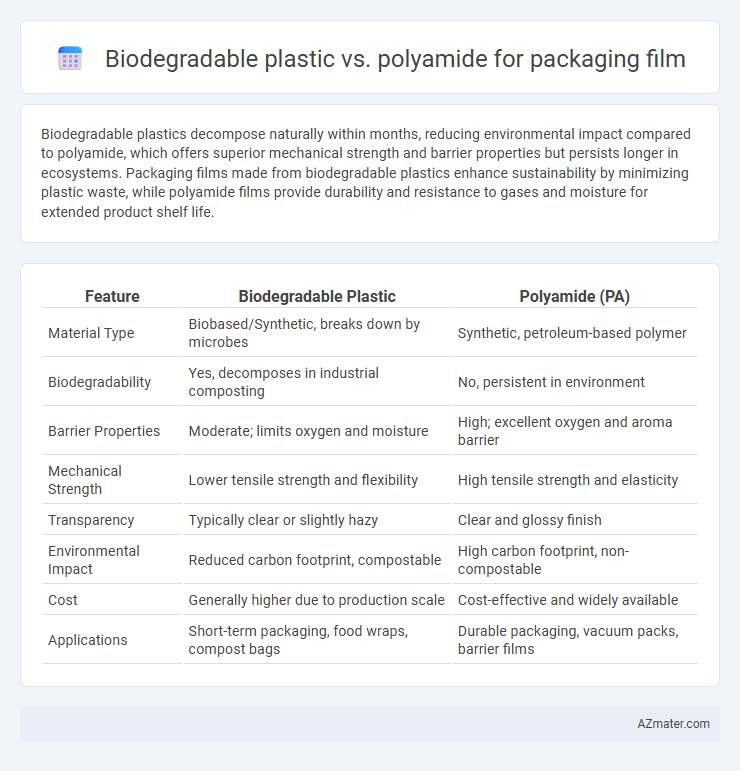Biodegradable plastics decompose naturally within months, reducing environmental impact compared to polyamide, which offers superior mechanical strength and barrier properties but persists longer in ecosystems. Packaging films made from biodegradable plastics enhance sustainability by minimizing plastic waste, while polyamide films provide durability and resistance to gases and moisture for extended product shelf life.
Table of Comparison
| Feature | Biodegradable Plastic | Polyamide (PA) |
|---|---|---|
| Material Type | Biobased/Synthetic, breaks down by microbes | Synthetic, petroleum-based polymer |
| Biodegradability | Yes, decomposes in industrial composting | No, persistent in environment |
| Barrier Properties | Moderate; limits oxygen and moisture | High; excellent oxygen and aroma barrier |
| Mechanical Strength | Lower tensile strength and flexibility | High tensile strength and elasticity |
| Transparency | Typically clear or slightly hazy | Clear and glossy finish |
| Environmental Impact | Reduced carbon footprint, compostable | High carbon footprint, non-compostable |
| Cost | Generally higher due to production scale | Cost-effective and widely available |
| Applications | Short-term packaging, food wraps, compost bags | Durable packaging, vacuum packs, barrier films |
Introduction to Biodegradable Plastics and Polyamide Films
Biodegradable plastics are engineered to break down naturally through microbial activity, reducing environmental impact compared to conventional plastics. Polyamide films, commonly known as nylon, offer excellent mechanical strength, chemical resistance, and barrier properties, making them ideal for packaging applications requiring durability. The choice between biodegradable plastics and polyamide films hinges on balancing sustainability goals with performance demands in packaging solutions.
Environmental Impact: Biodegradability vs Recyclability
Biodegradable plastic packaging films degrade naturally through microbial activity, reducing landfill accumulation and minimizing long-term environmental pollution. Polyamide films offer high recyclability but persist in the environment if not properly recycled, contributing to plastic pollution. Choosing between these materials involves balancing the benefits of biodegradability against the established recycling infrastructure supporting polyamide films.
Material Composition and Sources
Biodegradable plastic packaging films are primarily composed of natural polymers like polylactic acid (PLA), polyhydroxyalkanoates (PHA), and starch-based materials derived from renewable resources such as corn, sugarcane, and cellulose. Polyamide films consist of synthetic polymers made from petroleum-based monomers, specifically caprolactam or hexamethylene diamine and adipic acid, resulting in materials like nylon-6 and nylon-6,6. The renewable origin of biodegradable plastics contrasts with the fossil fuel dependency of polyamides, influencing their environmental footprint and end-of-life options.
Mechanical Properties: Strength and Flexibility
Biodegradable plastics for packaging films typically exhibit lower tensile strength and reduced elongation at break compared to polyamide films, impacting durability under stress. Polyamide films provide superior mechanical properties, including high tensile strength and excellent flexibility, making them ideal for applications requiring robust and stretchable packaging. The enhanced barrier performance of polyamides also complements their mechanical resilience, ensuring better protection for packaged goods over time.
Barrier Properties: Oxygen and Moisture Resistance
Biodegradable plastic films generally offer moderate oxygen and moisture barrier properties, with materials like polylactic acid (PLA) showing higher permeability compared to conventional polymers. Polyamide films exhibit superior oxygen barrier performance due to their dense molecular structure and strong intermolecular forces, making them ideal for extending the shelf life of oxygen-sensitive products. Moisture resistance in polyamide films is relatively lower, but multilayer structures combining polyamide with moisture-barrier layers enhance overall packaging effectiveness.
Cost Analysis and Market Availability
Biodegradable plastic packaging films typically incur higher production costs due to raw material sourcing and limited manufacturing scale, whereas polyamide films benefit from economies of scale and well-established supply chains, resulting in lower unit prices. Market availability of polyamide films is extensive, supported by widespread industrial adoption and diverse applications, while biodegradable plastics face restricted availability constrained by fewer producers and regional regulatory incentives. Cost competitiveness and accessibility currently favor polyamide films in mainstream packaging, though rising environmental regulations and consumer demand are gradually expanding the biodegradable plastic market.
Packaging Applications in Different Industries
Biodegradable plastic offers sustainable packaging solutions for the food and agriculture industries, reducing environmental impact through compostability and reduced plastic waste. Polyamide films provide excellent barrier properties, durability, and heat resistance, making them ideal for pharmaceutical, electronics, and high-performance food packaging applications. Each material's unique characteristics drive their adoption across sectors where biodegradability or mechanical and barrier performance are prioritized.
Consumer Perception and Regulatory Standards
Biodegradable plastic packaging films are increasingly favored by environmentally conscious consumers due to their reduced ecological footprint and compatibility with stringent regulatory standards such as the European Union's Single-Use Plastics Directive. Polyamide films, while offering superior mechanical strength and barrier properties, often face consumer skepticism over sustainability, despite compliance with food safety and packaging regulations like FDA and EFSA requirements. Regulatory frameworks are progressively encouraging the adoption of biodegradable materials, influencing both market demand and industry shifts toward sustainable packaging solutions.
End-of-Life Scenarios: Composting vs Recycling
Biodegradable plastics for packaging film offer end-of-life benefits through industrial composting, where microorganisms break down the material into water, carbon dioxide, and biomass within months, reducing landfill impact and greenhouse gas emissions. In contrast, polyamide films are primarily recycled through mechanical or chemical processes that recover polymer chains, enabling multiple reuse cycles but requiring sophisticated sorting and wash systems to maintain material quality. Composting biodegradable plastics is limited by infrastructure availability and contamination risks, while polyamide recycling faces challenges from multi-layer packaging structures and potential downcycling, influencing sustainability outcomes based on regional waste management systems.
Future Trends in Sustainable Packaging Films
Biodegradable plastics for packaging films are gaining traction due to increasing environmental regulations and consumer demand for eco-friendly alternatives, offering benefits such as reduced landfill waste and lower carbon footprints compared to traditional synthetics. Polyamide films, known for their excellent mechanical strength, barrier properties, and thermal stability, are evolving through advancements in bio-based polyamide formulations that aim to enhance sustainability without compromising performance. Future trends indicate a shift toward hybrid materials combining biodegradable polymers and bio-based polyamides, driving innovation in sustainable packaging films that balance functionality, recyclability, and environmental impact.

Infographic: Biodegradable plastic vs Polyamide for Packaging film
 azmater.com
azmater.com